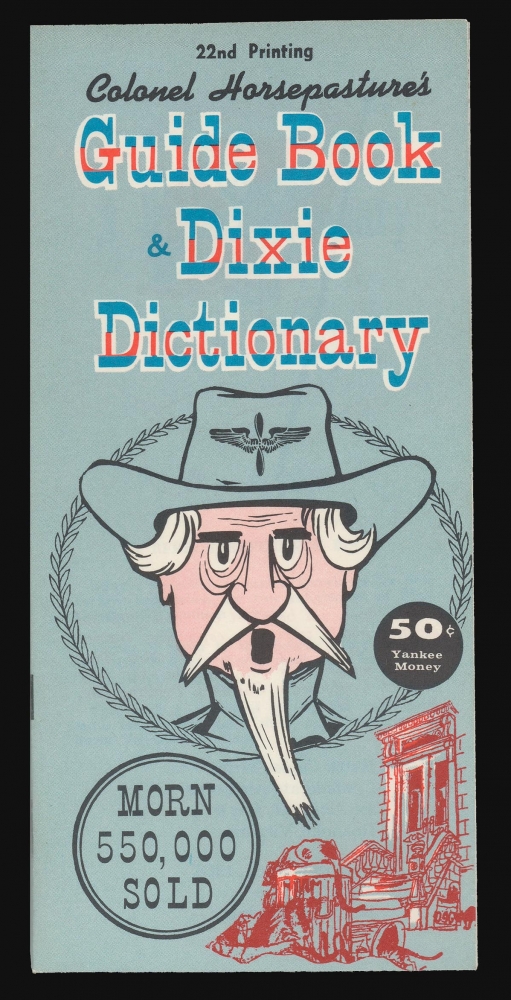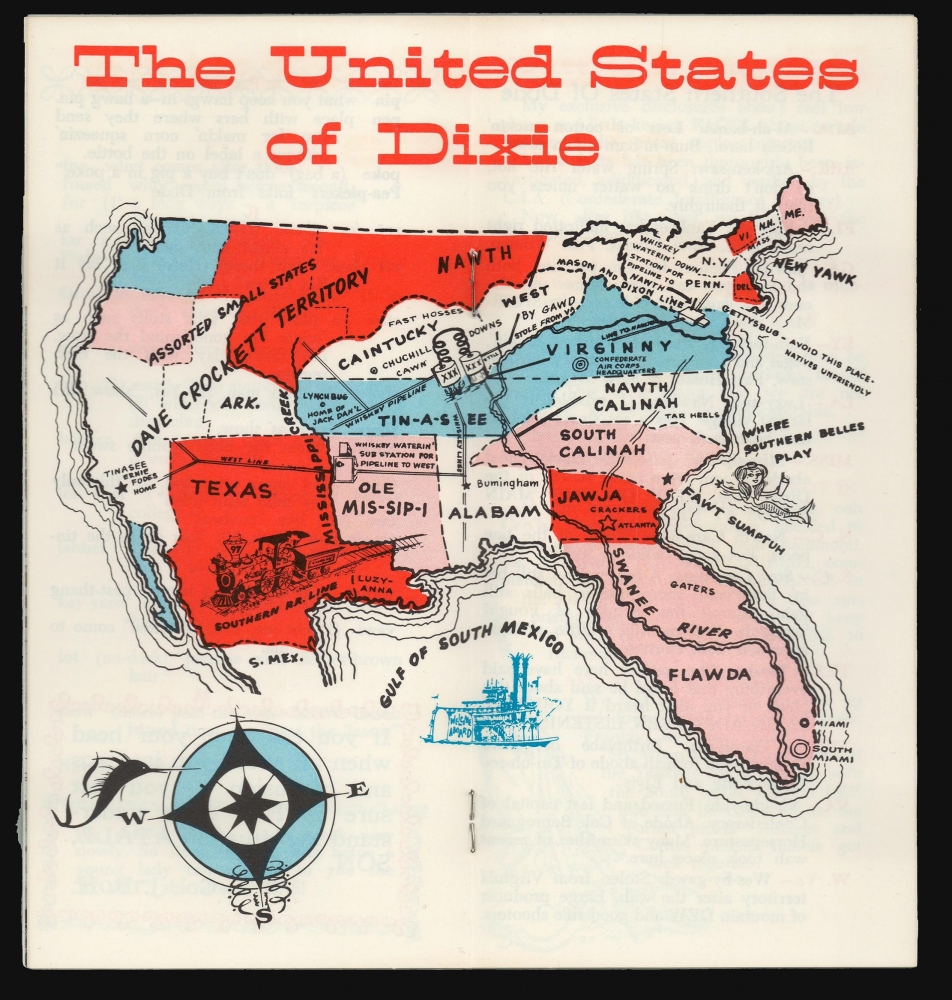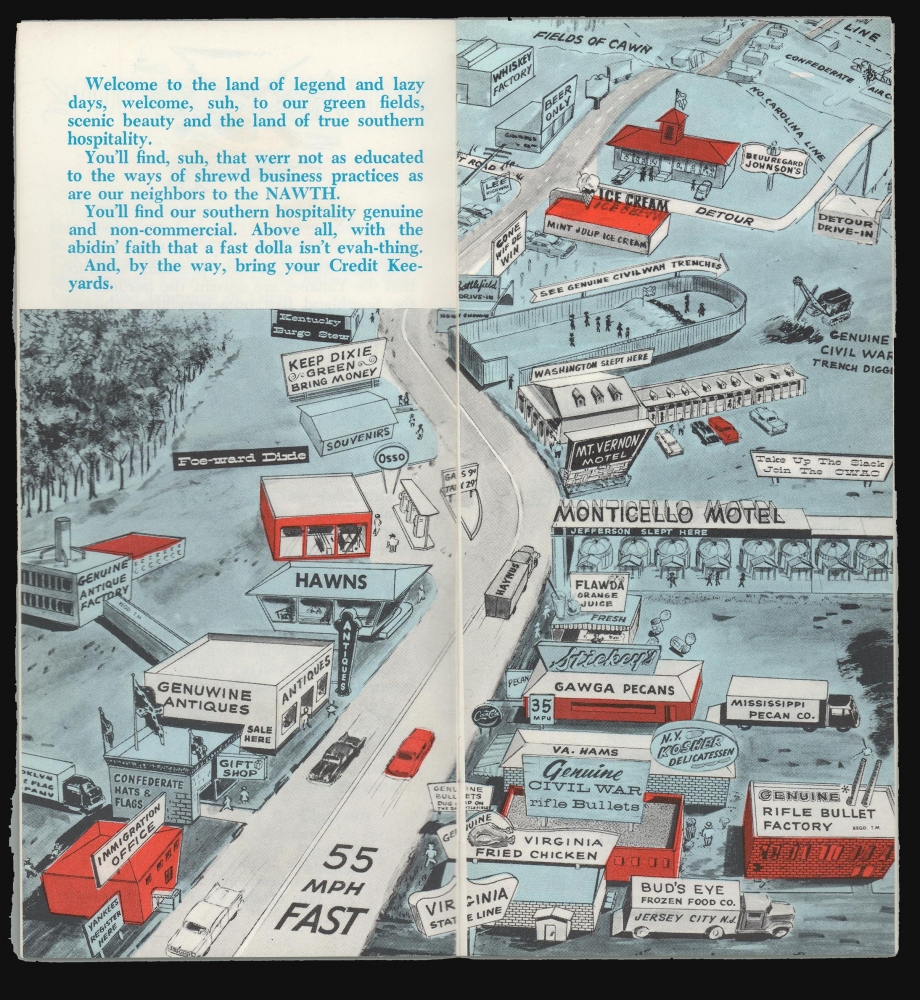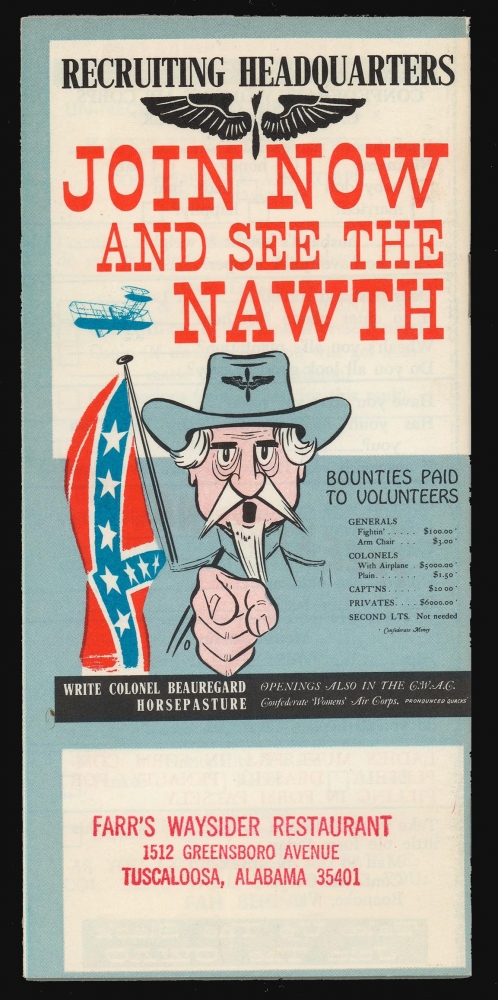This item has been sold, but you can get on the Waitlist to be notified if another example becomes available.
1961/68 Guide To Southern Dialect and Customs with a Map of the United States in a Southerner's Eyes
DixieDictionary-clark-1961
Title
1961 (dated) x in (0 x 0 cm)
Description
A Closer Look
The guide, presented as 'a collection of useless knowledge for both Yankees and Rebels, for true enlightment of Dixie Doing's and Southern Sayin's', was presented in stereotypically illiterate 'southern' dialect, both in the body of the work and in its titular dictionary entries. When pressed on the schtick in a 1970 interview by the Roanoke Times, Clark said, 'The Southerners get a kick out of it... and The Northerners DO believe we talk that way'.The Map
The guide includes a reduced version of Clark's map, 'The United States of Dixie', purportedly a distorted view of the United States through the eyes (and dialect) of a Southerner. Prominent place is given to the states of Flawda, Jawja, North and South Calinah, Virginny, Caintucky, Tin-a-See, Alabam, and Ole Mis-sip-i. Texas dominates the southwest from Louisiana to what might be construed as Arizona. The northeast is reduced to a tiny corner of land beyond the note 'Gettysburg - Avoid this place natives unfriendly'. The north and west parts of the country are labeled 'Dave Crockett Territory', 'Nawth', and 'Assorted Small States'. West Virginia is marked 'West by gawd stole from VA.' At the center of the country - that is to say, Caintucky and Tin-a-See - are two massive whiskey stills. From these, pipelines span the country -albeit interrupted in the northeast and southwest by 'Whiskey Waterin' Down stations' catering to the presumably stunted drinking abilities of Yankees and Westerners.Confederate Tourist Kitsch
The guide was intended for sale at roadside shops and eateries, primarily for the tourist market; a blank space was left on the back cover for the address of the specific seller (in this case, 'Farr's Waysider Restaurant' of Tuscaloosa.) As such, the tone of the book is light and self-deprecating. Clark pokes fun at the hucksterism inherent in the tourist trade (note, for example, the conveyor belts connecting) the shop selling 'Genuwine Antiques' and its supplier, the 'Genuine Antique Factory;' and the shop selling 'Confderat Hats and Flags' supplied by a truck from the 'Brooklyn Flag Company.' The whole presentation of the postwar south is also played off as kitch: Colonel Beauregard Horsepasture, for example, is Colonel of the 'Confederate Air Force' whose recruiting ad on the back cover features a ludicrously antique Wright Brothers-style aircraft. In treating the war as lightly as he does, Clark avoided completely any reference to the conflict's causes. The confederate iconography (inclusive of prominent use of the confederate flag) would not have been taken as seriously then as now (it is well to note that the popular telvision program, The Dukes of Hazzard would feature the 'rebel flag' prominently, and it did not air until 1979. The candy-coating of the confederacy represented here likewise completely ignores the civil rights movement which was in full swing as this booklet was published. Viewing it now, in the context of a United States facing active insurrectionist movements embracing confederate hagiography, it is virtually impossible to view this pamphlet in the light in which it was written. Light as its intentions may have been, the humor of the document can at best be described as 'unreconstructed.'Publication History and Census
This booklet was first published in 1961 by Charles F. Clark's Tip'n Twinkle company, and we are aware of editions (produced with minimal change) as late as 1968. The present example is dated 1968. We see two examples (1961 and 1968) in institutional collections, although this is likely the product of neglect more than a reflection of rarity.Cartographer
Charles Fenstermacher Clark (March 30, 1915 - September 30, 1988) was an American author, jeweler, inventor, and publisher. His firm, Tip'n Twinkle, entered business in order to market Clark's device for the easy cleaning of diamond rings (essentially a plastic bottle of detergent with a plastic rod to support a ring in the solution - hence, 'Tip'n Twinkle'). He went on to use the business to sell an array of novelty products, including matchbooks, placemats and humorous decorative placards in the 1950s, '60s and '70s. Most notably these included the 1961 'Colonel Horsepasture's Guide Book and Dixie Dictionary', written in stereotypically illiterate 'southern' dialect. 'The Southerners get a kick out of it... and The Northerners DO believe we talk that way.' He also published a satire on the medical profession, 'Friend or Enema'. In a more tasteful vein, the firm also sold blank picture albums for collecting childrens' photographs throughout their school years. Other novelties of his included a belly button lint brush, a 'Balloon Wine Making Kit,' and a rubber stamp for cancelling mail with the text, 'Republica de Cuba, Sensura, Officia Inspecto, Hi-Jak Par Aeroplano.' More by this mapmaker...








